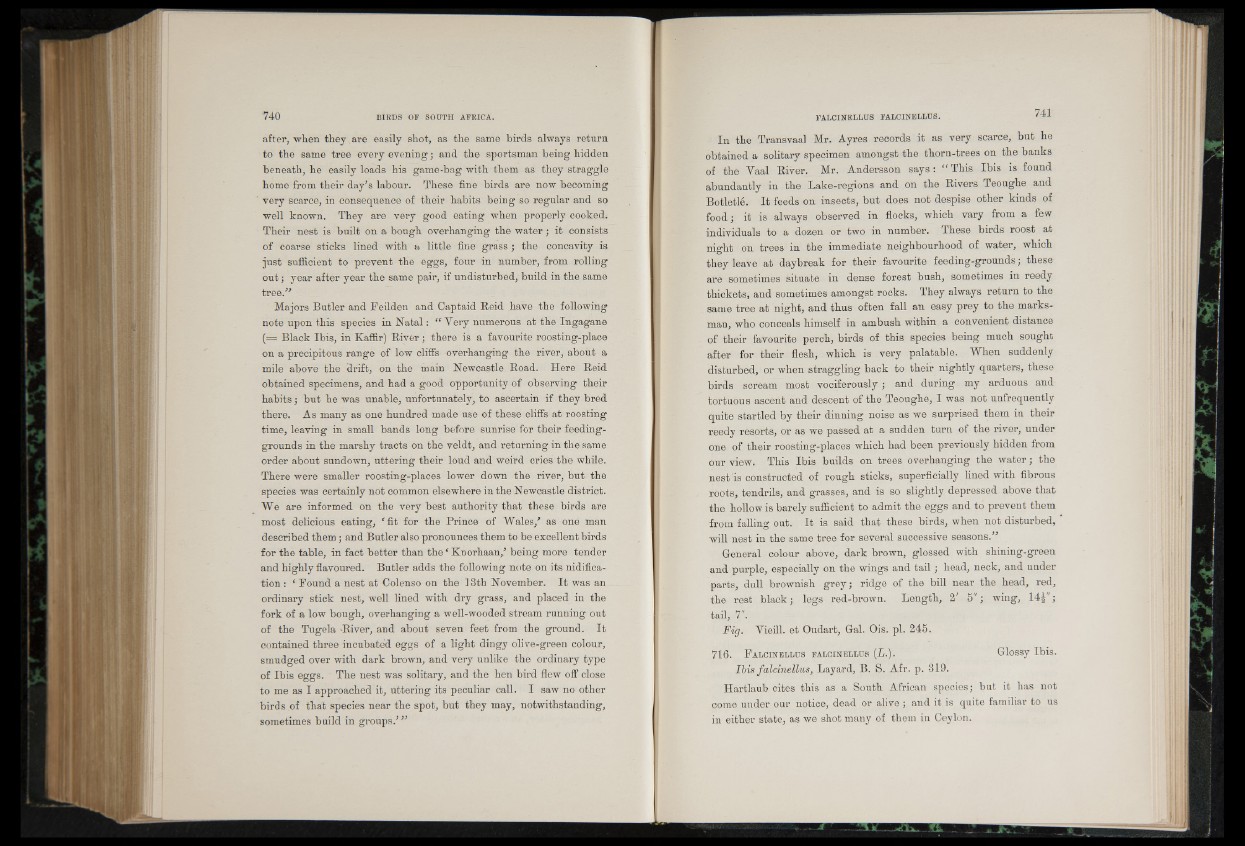
after, when they are easily shot, as the same birds always return
to the same tree every evening; and the sportsman being hidden
beneath, he easily loads his game-bag with them as they straggle
home from their day’s labour. These fine birds are now becoming
very scarce, in consequence of their habits being so regular and so
well known. They are very good eating when properly cooked.
Their nest is built on a bough overhanging the water; it consists
of coarse sticks lined with a little fine grass ; the concavity is
just sufficient to prevent the eggs, four in number, from rolling
out; year after year the same pair, if undisturbed, build in the same
tree.”
Majors Butler and Feilden and Captaid Reid have the following
note upon this species in Natal: “ Very numerous at the Ingagane
(— Black Ibis, in Kaffir) River; there is a favourite roosting-place
on a precipitous range of low cliffs overhanging the river, about a
mile above the drift, on the main Newcastle Road. Here Reid
obtained specimens, and had a good opportunity of observing their
habits; but he was unable, unfortunately, to ascertain if they bred
there. As many as one hundred made use of these cliffs at roosting
time, leaving in small bands long before sunrise for their feeding-
grounds in the marshy tracts on the veldt, and returning in the same
order about sundown, uttering their loud and weird cries the while.
There were smaller roosting-places lower down the river, but the
species was certainly not common elsewhere in the Newcastle district.
We are informed on the very best authority that these birds are
most delicious eating, ‘fit for the Prince of Wales,’ as one man
described them; and Butler also pronounces them to be excellent birds
for the table, in fact better than the jjj Knorhaan,’ being more tender
and highly flavoured. Butler adds the following note on its nidifica-
tion : ‘ Found a nest at Colenso on the 13th November. It was an
ordinary stick nest, well lined with dry grass, and placed in the
fork of a low bough, overhanging a well-wooded stream running out
of the Tugela River, and about seven feet from the ground. It
contained three incubated eggs of a light dingy olive-green colour,
smudged over with dark brown, and very unlike the ordinary type
of Ibis eggs. The nest was solitary, and the hen bird flew off close
to me as I approached it, uttering its peculiar call. I saw no other
birds of that species near the spot, but they may, notwithstanding,
sometimes build in groups.’”
In the Transvaal Mr. Ayres records it as very scarce, but he
obtained a solitary specimen amongst the thorn-trees on the banks
of the Vaal River. Mr. Andersson says: “ This Ibis is found
abundantly in the Lake-regions and on the Rivers Teoughe and
Botletle. It feeds on insects, but does not despise other kinds of
food; it is always observed in flocks, which vary from a few
individuals to a dozen or two in number. These birds roost at
night on trees in the immediate neighbourhood of water, which
they leave at daybreak for their favourite feeding-grounds; these
are sometimes situate in dense forest bush, sometimes in reedy
thickets, and sometimes amongst rocks. They always return to the
same tree at night, and thus often fall an easy prey to the marksman,
who conceals himself in ambush within a convenient distance
of their favourite perch, birds of this species being much sought
after for their flesh, which is very palatable. When suddenly
disturbed, or when straggling back to their nightly quarters, these
birds scream most vociferously; and during my arduous and
tortuous ascent and descent of the Teoughe, I was not unfrequently
quite startled by their dinning noise as we surprised them in their
reedy resorts, or as we passed at a sudden turn of the river, under
one of their roosting-places which had been previously hidden from
our view. This Ibis builds on trees overhanging the water; the
nest is constructed of rough sticks, superficially lined with fibrous
roots, tendrils, and grasses, and is so slightly depressed above that
the hollow is barely sufficient to admit the eggs and to prevent them
from falling out. It is said that these birds, when not disturbed,
will nest in the same tree for several successive seasons.”
General colour above, dark brown, glossed with shining-green
and purple, especially on the wings and ta il; head, neck, and under
parts, dull brownish grey; ridge of the bill near the head, red,
the rest black; legs red-brown. Length, 2' 5"; wing, 14£";
tail, 7".
Fig. Vieill. et Oudart, Gal. Ois. pi. 245.
716. FALCINELLUS FALCINELLUS (L.). G lo S S y Ibis.
Ibis falcinellus, Layard, B. S. Afr. p. 319.
Hartlaub cites this as a South African species; but it has not
come under our notice, dead or alive ; and it is quite familiar to us
in either state, as we shot many of them in Ceylon.